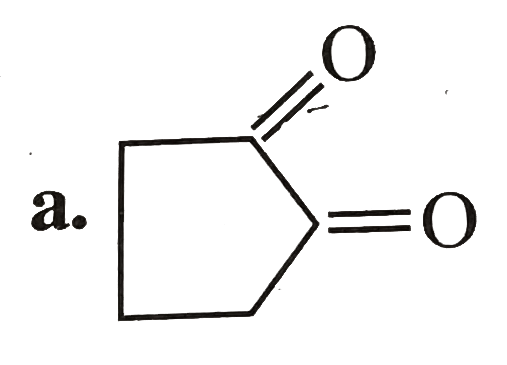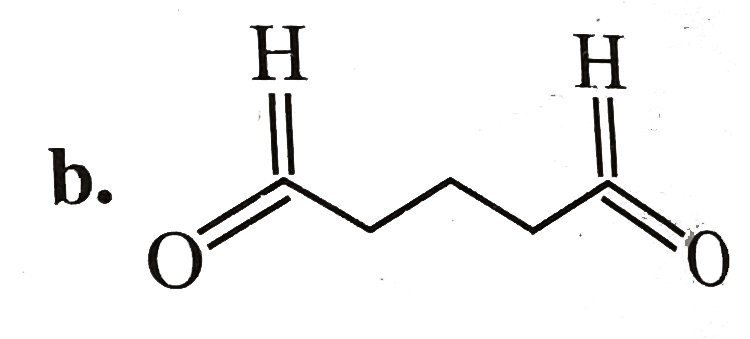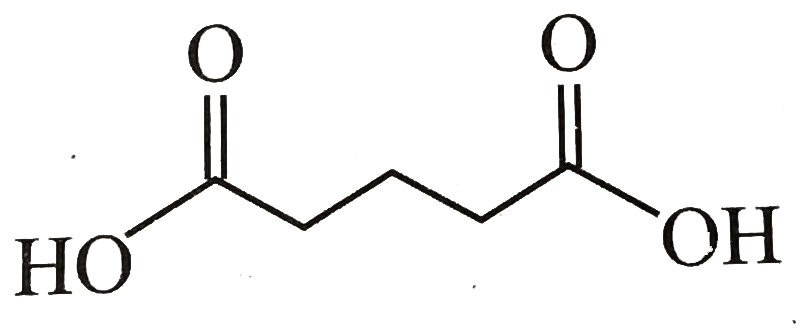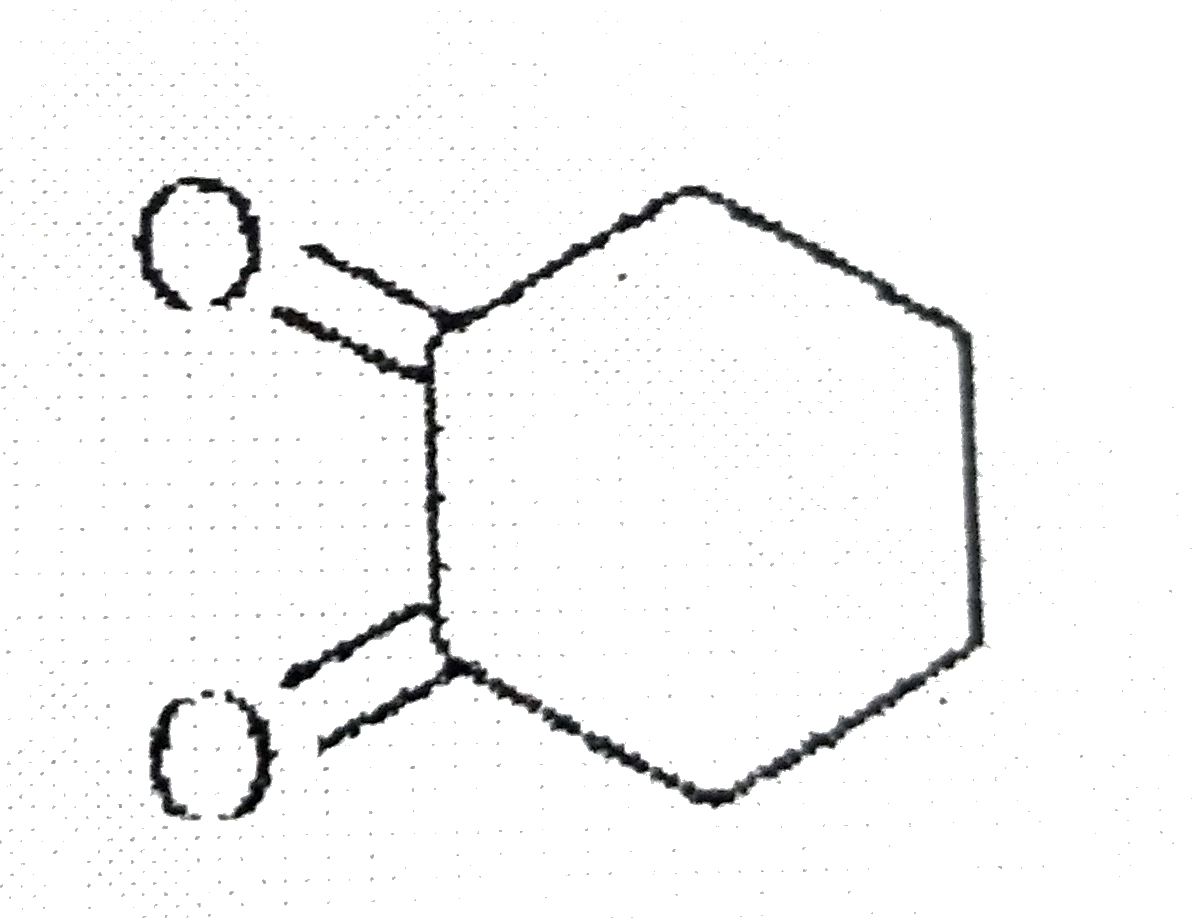Oxidation product of 1,2-cyclopentane-diol with is



none is correct
The correct Answer is:A
To determine the oxidation product of 1,2-cyclopentane-diol when reacted with periodic acid (HIO4), we can follow these steps:
Step 1: Understand the Structure of 1,2-Cyclopentane-Diol
1,2-Cyclopentane-diol is a cyclic compound with a five-membered ring (cyclopentane) and two hydroxyl (OH) groups located on adjacent carbon atoms (1 and 2). The structure can be represented as follows:
OH∣C1−C2C5C3 C4
Step 2: Identify the Reaction with HIO4
Periodic acid (HIO4) is known to oxidize vicinal diols (diols with hydroxyl groups on adjacent carbons) by cleaving the C-C bond between the two carbons that bear the hydroxyl groups. This reaction typically results in the formation of carbonyl compounds (aldehydes or ketones).
Step 3: Apply the Reaction Mechanism
In the case of 1,2-cyclopentane-diol, the two hydroxyl groups on carbons 1 and 2 are adjacent. When HIO4 reacts with this diol, it will cleave the bond between C1 and C2, resulting in the formation of two carbonyl groups.
Step 4: Determine the Products
After the cleavage, the resulting products will be:
- A carbonyl compound (aldehyde or ketone) from the cleavage of the C-C bond.
- The remaining part of the ring will also be affected, leading to the formation of a new structure.
The final product will be a compound with a double bond to oxygen (C=O) at the positions where the hydroxyl groups were originally located.
Step 5: Write the Final Structure
The final product can be represented as follows:
O∣∣C1−C2C5C3 C4
This structure indicates that the original cyclopentane ring has been transformed, and we have a carbonyl group at the position where the hydroxyl groups were located.
Conclusion
The oxidation product of 1,2-cyclopentane-diol with HIO4 is a compound with two carbonyl groups formed from the cleavage of the vicinal diols.
---
1,2-Cyclopentane-diol is a cyclic compound with a five-membered ring (cyclopentane) and two hydroxyl (OH) groups located on adjacent carbon atoms (1 and 2). The structure can be represented as follows:
Periodic acid (HIO4) is known to oxidize vicinal diols (diols with hydroxyl groups on adjacent carbons) by cleaving the C-C bond between the two carbons that bear the hydroxyl groups. This reaction typically results in the formation of carbonyl compounds (aldehydes or ketones).
In the case of 1,2-cyclopentane-diol, the two hydroxyl groups on carbons 1 and 2 are adjacent. When HIO4 reacts with this diol, it will cleave the bond between C1 and C2, resulting in the formation of two carbonyl groups.
After the cleavage, the resulting products will be:
- A carbonyl compound (aldehyde or ketone) from the cleavage of the C-C bond.
- The remaining part of the ring will also be affected, leading to the formation of a new structure.
The final product can be represented as follows:
The oxidation product of 1,2-cyclopentane-diol with HIO4 is a compound with two carbonyl groups formed from the cleavage of the vicinal diols.
Topper's Solved these Questions
- GENERAL ORGANIC CHEMISTRYBook:FIITJEEChapter:GENERAL ORGANIC CHEMISTRYExercise:MORE THAN ONE CORRECT CHOICES
Explore 24 Videos
- GENERAL ORGANIC CHEMISTRYBook:FIITJEEChapter:GENERAL ORGANIC CHEMISTRYExercise:COMPREHENSION TYPE
Explore 18 Videos
- GENERAL ORGANIC CHEMISTRYBook:FIITJEEChapter:GENERAL ORGANIC CHEMISTRYExercise:Section (I) [Jee mains]: With Single Correct Choice
Explore 100 Videos
- GASEOUS STATEBook:FIITJEEChapter:GASEOUS STATEExercise:MATCHING LIST TYPE QUESTION
Explore 1 Video
- HYDROCARBONSBook:FIITJEEChapter:HYDROCARBONSExercise:SINGLE INTEGER ANSWER TYPE QUESTION
Explore 9 Videos
Similar Questions
Knowledge Check
The oxidation product of 1,2-cyclopentane diol with HIO4 or (CH3COO)4Pb is:
Aa. Bb.
Bb. Cc.
Cc. Dd. None
Dd. NoneOxidaton product 1,2-eyelopentanediol with HlO4 gives
AHC∣∣O−CH2−CH2−CH2−C∣∣O−HB CO=C∣OH−CH−CH2−CH2−C∣OH=ODnone of these
CO=C∣OH−CH−CH2−CH2−C∣OH=ODnone of theseOxidation of 2-methyl propane-1,2-diol with periodic acid gives:-
APropionic acid and formaldehydeBAcetone and formaldehydeCAcetone and acetic acidDAcetone and propionic acid
Dehydration product of 1,4 -diol given below will be :
CH3C∣OHHCH2CH2C∣O18HH2H⊕−−→△
View SolutionThe major product obtained when 3-phenyl-1,2-propane-diol is heated with H2SO4 is
View SolutionFor the reaction: I−+ClO−3+H2SO4→Cl−+HSO−4+I2 The correct statement(s) in the balanced equation is/are
(1) Stoichiometric coefficient of HSO−4 is 6
(2) Iodide is oxidized.
(3) Oxidation number of chlorine changes by 5 units
(4) H2O is one of the products
View SolutionEthane-1,2-diol when heated with ZnCl2 gives
View SolutionMost stalbe conformation of 1,4-cycohexane diol in its cis from is :
View Solution
